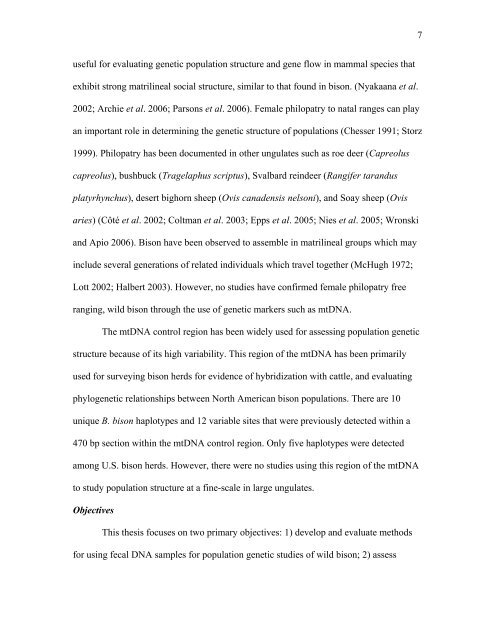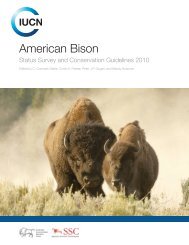Declaration Dr. Thomas H. Pringle - Buffalo Field Campaign
Declaration Dr. Thomas H. Pringle - Buffalo Field Campaign
Declaration Dr. Thomas H. Pringle - Buffalo Field Campaign
You also want an ePaper? Increase the reach of your titles
YUMPU automatically turns print PDFs into web optimized ePapers that Google loves.
useful for evaluating genetic population structure and gene flow in mammal species that<br />
exhibit strong matrilineal social structure, similar to that found in bison. (Nyakaana et al.<br />
2002; Archie et al. 2006; Parsons et al. 2006). Female philopatry to natal ranges can play<br />
an important role in determining the genetic structure of populations (Chesser 1991; Storz<br />
1999). Philopatry has been documented in other ungulates such as roe deer (Capreolus<br />
capreolus), bushbuck (Tragelaphus scriptus), Svalbard reindeer (Rangifer tarandus<br />
platyrhynchus), desert bighorn sheep (Ovis canadensis nelsoni), and Soay sheep (Ovis<br />
aries) (Côté et al. 2002; Coltman et al. 2003; Epps et al. 2005; Nies et al. 2005; Wronski<br />
and Apio 2006). Bison have been observed to assemble in matrilineal groups which may<br />
include several generations of related individuals which travel together (McHugh 1972;<br />
Lott 2002; Halbert 2003). However, no studies have confirmed female philopatry free<br />
ranging, wild bison through the use of genetic markers such as mtDNA.<br />
The mtDNA control region has been widely used for assessing population genetic<br />
structure because of its high variability. This region of the mtDNA has been primarily<br />
used for surveying bison herds for evidence of hybridization with cattle, and evaluating<br />
phylogenetic relationships between North American bison populations. There are 10<br />
unique B. bison haplotypes and 12 variable sites that were previously detected within a<br />
470 bp section within the mtDNA control region. Only five haplotypes were detected<br />
among U.S. bison herds. However, there were no studies using this region of the mtDNA<br />
to study population structure at a fine-scale in large ungulates.<br />
Objectives<br />
This thesis focuses on two primary objectives: 1) develop and evaluate methods<br />
for using fecal DNA samples for population genetic studies of wild bison; 2) assess<br />
7










